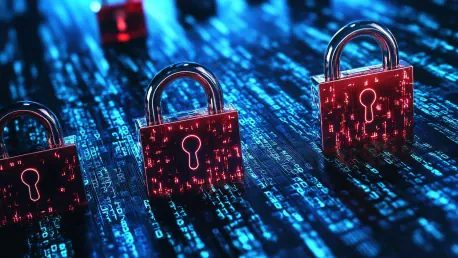The cybersecurity landscape is rapidly evolving, with new threats and technologies emerging at an unprecedented pace. As we look towards 2025, enterprises must adapt their security strategies to address these challenges and safeguard their operations. This article explores the key trends, threats, and strategic responses that will shape cybersecurity in the coming years.
The Rise of Ransomware and AI-Powered Cyber Threats
Ransomware attacks have become increasingly sophisticated, leveraging advanced techniques to infiltrate and disrupt enterprise systems. By 2025, these attacks are expected to grow in frequency and complexity, necessitating a proactive approach to cyber-resiliency. Ransomware attackers are not only locking up data but also exfiltrating it to further extort organizations, leading to crippling financial losses and reputational damage. Additionally, ransomware-as-a-service (RaaS) is lowering the barrier for entry-level cybercriminals, making it easier for them to launch devastating attacks.
AI-driven cyber threats are another significant concern for 2025. Cybercriminals are harnessing machine learning algorithms to enhance their attack strategies, making them more effective and harder to detect. Generative AI and deepfakes are being used for more precise reconnaissance, adaptive malware creation, and sophisticated phishing attempts. These AI-powered tools allow attackers to carry out surveillance and craft highly personalized social engineering attacks, posing a severe risk to enterprises. To counteract these threats, organizations need to invest in advanced threat detection and mitigation technologies, including AI-powered cybersecurity solutions that can outpace and outthink potential adversaries.
While AI technology is indeed a double-edged sword, it also holds the potential to significantly enhance security processes. For instance, AI can be used to improve data masking, incident response, and automate policy generation, providing enterprises with the tools they need to stay one step ahead of cybercriminals. By integrating AI into their cybersecurity strategies, organizations can achieve higher levels of threat detection accuracy and faster response times, ultimately bolstering their defenses against AI-driven cyber threats.
Embracing Zero-Trust Security Frameworks
Traditional network boundaries are dissolving due to the widespread adoption of cloud-native and distributed work environments, rendering the perimeter-based security model outdated. This shift necessitates a fundamental change in security strategies, with zero-trust security frameworks becoming essential. The zero-trust model operates on the principle of “never trust, always verify,” requiring continuous verification of digital interactions regardless of their origin. This approach ensures that all users and devices, both internal and external, are consistently authenticated and authorized before accessing sensitive data or systems.
Implementing a zero-trust framework involves several key components, including identity verification, access controls, and continuous monitoring. Identity verification ensures that the individual or device trying to access the system is indeed who or what they claim to be. Access controls manage permissions, granting only the necessary access to users based on their roles and responsibilities. Continuous monitoring helps detect and respond to suspicious activities in real time, preventing unauthorized lateral movement within the network. By adopting this approach, enterprises can better protect their systems and data from unauthorized access and lateral movement attacks.
With zero-trust becoming a cornerstone of cybersecurity strategy, organizations must prioritize its implementation to enhance their overall security posture. This involves re-evaluating existing security protocols, deploying new technologies, and fostering a culture of security awareness across all levels of the organization. Training employees on the principles and practices of zero-trust, ensuring adherence to stringent security policies, and regularly auditing security measures are essential steps in this direction. By committing to a zero-trust framework, enterprises can significantly reduce their attack surface and enhance their resilience against the evolving threat landscape.
Quantum Computing: A Double-Edged Sword
Quantum computing holds the potential to revolutionize encryption standards, offering stronger methods to protect sensitive data. The exponential increase in computational power that quantum computers promise could enable them to solve complex mathematical problems far more efficiently than classical computers. This could lead to breakthroughs in various fields, including cryptography, where quantum algorithms may be used to create virtually unbreakable encryption keys. However, this same capability also poses a significant threat to current encryption models, potentially rendering them obsolete.
The concern of “harvest now, decrypt later” attacks by nation-state actors highlights the urgency of adopting post-quantum cryptography solutions. In these scenarios, adversaries intercept and store encrypted data today, with the expectation that they will be able to decrypt it once quantum computing technology becomes advanced enough. This presents a significant risk, particularly for data that needs to remain confidential for many years. Therefore, it is imperative for enterprises to stay informed about advancements in quantum computing and prepare for its impact on their security infrastructures.
Enterprises must invest in research and development of post-quantum cryptographic algorithms to safeguard their data against future threats. Collaborating with industry experts, academic researchers, and government agencies can help accelerate the development and standardization of these new encryption methods. Additionally, organizations should start identifying which of their systems and data might be most vulnerable to quantum-based attacks and prioritize their transition to post-quantum cryptographic solutions. By taking proactive steps now, enterprises can ensure their encryption methods remain robust and future-proof against the impending quantum threat.
Enhancing Critical Data Protection
With the certainty of cyber-attacks, robust data protection strategies are integral to cybersecurity plans. Ensuring swift data recovery in the event of breaches and proactive investment in advanced cybersecurity measures are crucial for organizational resilience. Data breaches are not a matter of if but when, making it essential for enterprises to be prepared for such eventualities. This involves implementing comprehensive data encryption protocols, backup solutions, and incident response planning.
Advanced data protection also involves continuous monitoring and threat detection to identify and respond to security incidents in real time. By using sophisticated tools and technologies, organizations can monitor their networks for unusual activities, detect potential threats early, and take immediate action to mitigate them. Integrated Security Information and Event Management (SIEM) systems and Endpoint Detection and Response (EDR) tools play a vital role in this process, providing a centralized platform for monitoring, detecting, and responding to threats across the organization.
Enterprises must prioritize data encryption, not just for data at rest but also for data in transit. By encrypting data end-to-end, organizations can ensure that even if cybercriminals intercept the data, they will not be able to read it without the encryption keys. Regularly scheduled data backups are also essential, enabling organizations to quickly restore compromised data and minimize downtime. Furthermore, implementing a well-defined incident response plan can help organizations respond swiftly and effectively to data breaches, reducing their impact and ensuring a quicker recovery. By adopting these comprehensive data protection strategies, enterprises can safeguard their critical assets and maintain business continuity in the face of cyber threats.
Combatting Evolving Phishing Tactics
Phishing attacks are becoming increasingly sophisticated, with the evolution of phishing kits that enhance the ease and effectiveness of such attacks. Modern phishing campaigns leverage advanced tactics such as spear phishing, where attackers craft highly personalized emails that target specific individuals or organizations. These emails often appear legitimate and come from seemingly known and trusted sources, making them difficult to detect and prevent. To combat these evolving threats, enterprises must adopt advanced phishing-resistant authentication methods and block requests from anonymizing services.
Implementing multi-factor authentication (MFA) is a critical step in strengthening defenses against phishing attacks. MFA requires users to provide two or more verification factors to gain access to their accounts, making it significantly harder for attackers to compromise them. Biometric verification methods, such as fingerprint scanning and facial recognition, add an additional layer of security by ensuring that only authorized users can access sensitive information. Behavioral analytics can also be employed to detect anomalies in user behavior, identifying potential phishing attempts and mitigating them before any damage occurs.
Education and awareness are also critical components of phishing prevention. Organizations should conduct regular training sessions to educate employees about the latest phishing tactics and how to recognize and report suspicious activities. Employees must be trained to scrutinize email addresses, avoid clicking on suspicious links, and verify the legitimacy of unexpected attachments. By fostering a culture of cybersecurity awareness, enterprises can reduce the risk of successful phishing attacks and empower their workforce to act as the first line of defense against these threats.
Securing Interconnected Networks
As devices and services become more interconnected, the risk and complexity of cyber-attacks expand. The proliferation of Internet of Things (IoT) devices, cloud services, and remote work setups has created a vast and complex web of interconnected networks. Each connected device represents a potential entry point for cybercriminals, making it imperative for enterprises to implement advanced and automated machine-scale cybersecurity solutions to protect against these threats. Networks play a critical role in managing workloads and serving as primary defense lines against lateral movement attacks, where attackers move within the network to access additional systems and data.
To secure interconnected networks, enterprises must implement robust network segmentation, which involves dividing the network into smaller, isolated segments. This prevents attackers from moving laterally within the network and limits the scope of potential breaches. Intrusion detection and prevention systems (IDPS) are also essential, as they continuously monitor network traffic for signs of malicious activity and can automatically block suspicious connections. Automated threat response mechanisms can react to detected threats in real time, reducing the time it takes to mitigate attacks and minimizing their impact.
Continuous monitoring and real-time analytics are crucial for identifying and addressing potential threats before they can cause significant damage. By leveraging advanced analytics and machine learning algorithms, organizations can detect anomalies and patterns indicative of cyber-attacks, enabling them to respond proactively. Regular security audits and vulnerability assessments can help identify weaknesses in the network infrastructure, allowing organizations to address them before they are exploited by attackers. By adopting a holistic approach to network security, enterprises can better protect their interconnected systems and data, ensuring the integrity and availability of their critical assets.
Addressing Mobile Device Threats
The shift of financial malware from PCs to mobile devices presents new challenges for cybersecurity. As more employees use mobile devices for work-related tasks, these devices have become prime targets for cybercriminals. Mobile malware can steal sensitive data, track user activity, and even intercept communications, posing a significant threat to enterprise security. Enterprises must implement robust predictive analytics, continuous monitoring, and zero-trust frameworks to protect against these rising threats.
Mobile device management (MDM) solutions are essential components of a comprehensive mobile security strategy. MDM tools allow organizations to enforce security policies, manage device configurations, and remotely wipe data from lost or stolen devices. Encryption should be applied to both the data stored on the device and the data transmitted over networks to prevent unauthorized access. Secure application development practices, such as code obfuscation and regular security testing, can help reduce vulnerabilities in mobile apps and protect against malware infections.
As mobile devices become increasingly integral to business operations, organizations must prioritize their security to prevent data breaches and unauthorized access. Regularly updating the operating systems and applications on mobile devices is crucial for protecting against known vulnerabilities. Vulnerability assessments and penetration testing can help identify and remediate security weaknesses. Employee training on mobile security best practices is also vital, as many mobile malware infections occur due to user actions, such as downloading malicious apps or connecting to unsecured Wi-Fi networks. By implementing these robust security measures, enterprises can safeguard their mobile devices and protect sensitive corporate data from cyber threats.
Leveraging Agentic AI for Cybersecurity
The cybersecurity landscape is changing dramatically, with emerging threats and advancing technologies evolving faster than ever. By 2025, businesses must revamp their security strategies to confront these new challenges and protect their operations. It is crucial for enterprises to be proactive in their approach to cybersecurity, given the increasing sophistication of cyber attacks. Threats such as ransomware, phishing schemes, and advanced persistent threats are becoming more prevalent and devastating. Additionally, with the rise of the Internet of Things (IoT) and the expansion of cloud services, new vulnerabilities are constantly appearing.
Organizations need to implement comprehensive security measures, including regular updates and patches, employee training programs, and advanced threat detection systems. Zero Trust architecture, which assumes that threats could come from within the network itself, is becoming a standard practice.
Furthermore, partnerships between government bodies, private sector entities, and academia will play a critical role in forming an integrated defense mechanism. Cybersecurity is no longer a static field but one that requires continuous innovation and adaptation. As we head toward 2025, staying ahead of the curve in cybersecurity will be essential for businesses to operate safely and efficiently.









